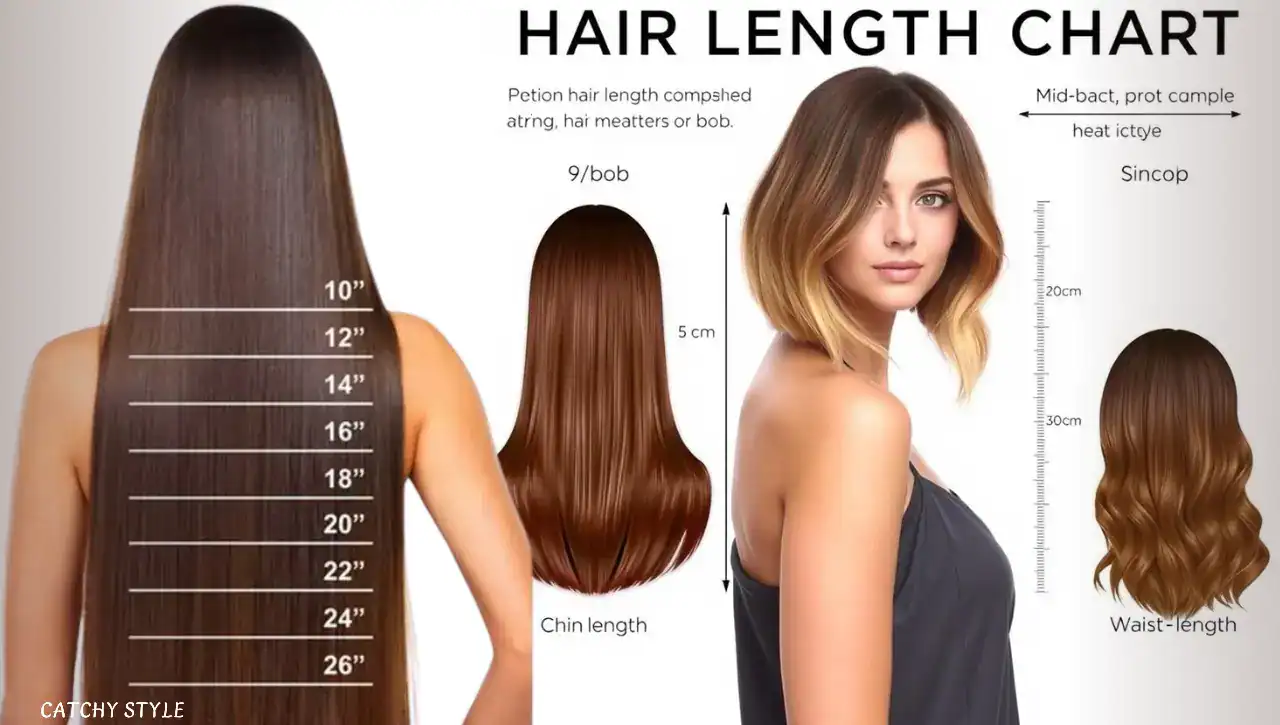
The Ultimate Guide to Understanding the Hair Length Chart
hair length chart is a useful tool for tracking growth, setting styling goals and exploring options for different lengths. Whether you’re aiming for a short haircut or long locks, this chart provides clarity and guidance for your hair journey.
In this Catchy Style article, we’ll guide you through the hair length chart, its categories, its uses and give you tips on how to achieve your desired length. By the end, you’ll know exactly how to use the chart to achieve your goals.
What is a Hair Length Chart?

hair length chart is a visual guide that categorizes hair lengths in increments, usually measured in inches or centimeters. It is used by hairdressers, trichologists and hair enthusiasts to define and track hair growth.
The chart includes categories such as short, medium, long and very long with specific measurements and styling options for each of these categories. This makes it a valuable tool for setting realistic goals and planning hair care.
The chart adapts to your hair growth, whether you want a short haircut or want to keep long hair. It also takes into account differences in hair texture, density and growth rate, making it a versatile tool for all hair types.
Why Use a Hair Length Chart?
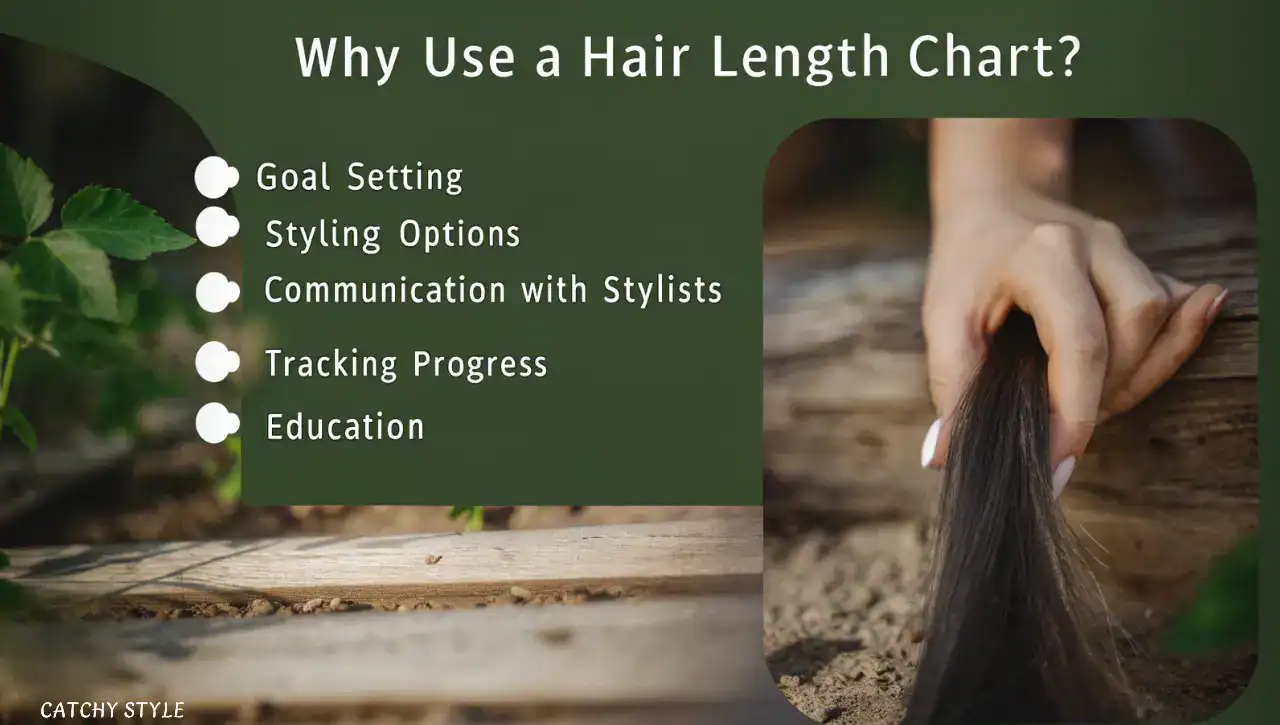
The hair length chart offers several advantages:
- Goal setting: it provides clear milestones for hair growth and keeps you motivated.
- Styling options: Each length category opens up new styling options, from updos to braids.
- Communicate with stylists: Use the chart to make sure you and your stylist are aligned.
- Track progress: By measuring your hair regularly, you can monitor growth and adjust your routine.
- Education: It shows how hair length affects maintenance, product usage and styling time.
Incorporating the hair length chart into your routine will give you a structured path to your ideal hairstyle.
Ultimate Hair Length Chart Guide
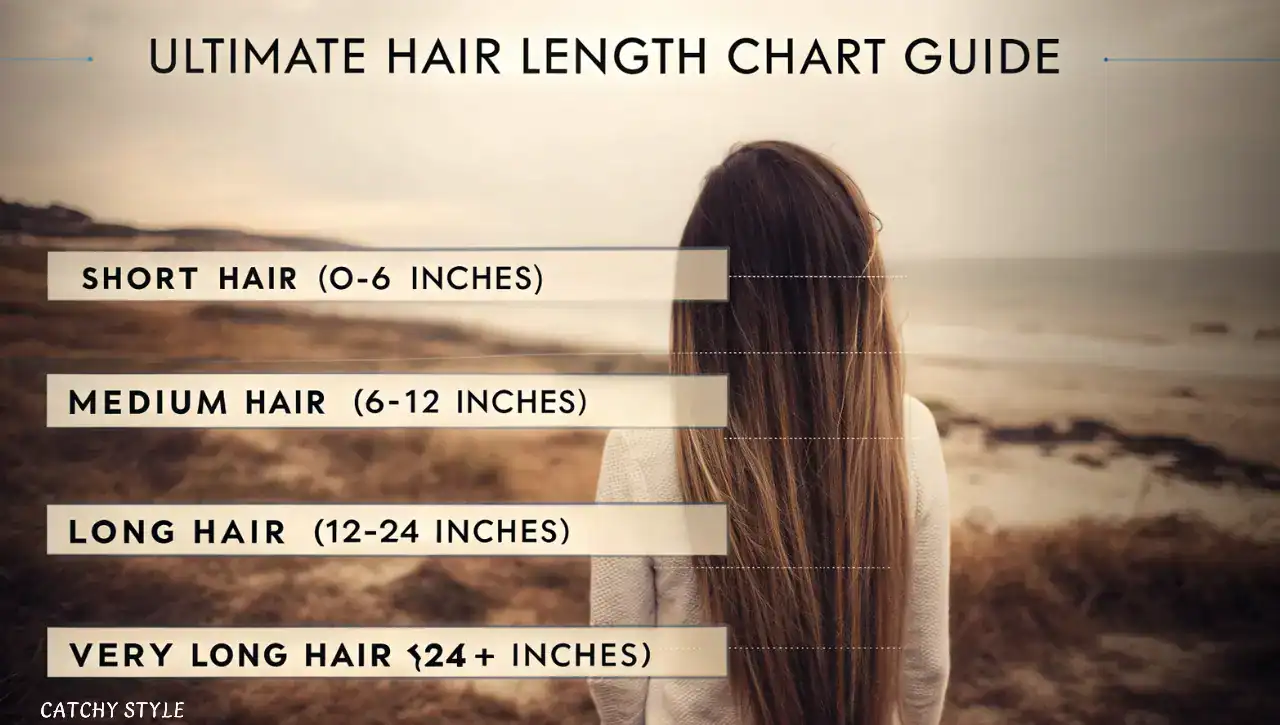
Understanding the hair length chart helps you set realistic goals and tailor your care routine. Below, we break down each category with precise measurements, styling ideas, and expert maintenance tips.
1. Short Hair (0–6 inches)
Bold and low-maintenance, perfect for pixie cuts or bobs. Requires trims every 4-6 weeks to keep its shape.
Key Styles: Pixie cuts, buzz cuts, short bobs, undercuts
Styling Tips:
- Add texture with sea salt spray for a lived-in look.
- Slick back with pomade for a polished finish.
Care Routine:
- Trim every 4–6 weeks to maintain shape.
- Use a scalp serum (like rosemary oil) to promote growth.
Growth Timeline:
- *Buzz cut (0 inches) to chin-length bob (6 inches):* 12–18 months
Pro Tip: Short hair grows faster visually—celebrate small milestones!
2. Medium Hair (6–12 inches)
Versatile shoulder-length hair ideal for waves or half-up styles. Needs trimming every 6-8 weeks to prevent split ends.
Key Styles: Lob (long bob), shag, shoulder-length layers
Styling Tips:
- Create heatless waves with robe ties overnight.
- Try a “lob flip” with a curling iron for retro vibes.
Care Routine:
- Trim every 6–8 weeks to prevent split ends.
- Use a bond-repair treatment (e.g., Olaplex) if heat-styling often.
Growth Timeline:
- *Chin-length (6 inches) to bra-strap length (12 inches):* 12–24 months
Did You Know? Medium hair is the most requested length in salons.
3. Long Hair (12–24 inches)
Elegant and flowing, great for braids or ponytails. Trim every 8-12 weeks to maintain healthy ends.
Key Styles: Mermaid waves, ballet buns, waterfall braids
Styling Tips:
- Use spin pins (not elastics) to secure updos without breakage.
- Try “blowout therapy” with a round brush for salon-worthy volume.
Care Routine:
- Trim every 8–12 weeks—focus on “dusting” (micro-trims).
- Sleep in a loose braid on silk pillowcases to prevent friction.
Growth Timeline:
- *Shoulder-length (12 inches) to waist-length (24 inches):* 24–48 months
Warning: Long hair is prone to “mechanical damage” from brushing/styling. Always detangle from ends up!
4. Very Long Hair (24+ inches)
A stunning statement length requiring extra care. Get trims every 3-4 months and use protective styles to prevent damage.
Key Styles: Classic lengths (hip/tailbone), fairy-tale braids
Styling Tips:
- Use hair forks (not clips) to distribute weight in updos.
- Apply a light oil (e.g., jojoba) to ends daily to prevent dryness.
Care Routine:
- Trim every 3–4 months—focus on preventing “fairy knots.”
- Clarify monthly to avoid buildup at the scalp.
Growth Timeline:
- *Waist-length (24 inches) to classic length (36 inches):* 4–6+ years
Reality Check: Genetics cap most people’s growth at 30–36 inches (the “terminal length”).
How to Use This Guide
- Measure Properly: Use a fabric tape measure from roots to ends when dry.
- Customize Care: Fine hair? Use volumizing sprays. Thick hair? Prioritize moisture.
- Track Progress: Take monthly photos in the same shirt/lighting.
Final Thought: The hair length chart isn’t just about length—it’s about healthy growth. Adjust routines as you move between categories!
Standard Hair Length Chart Measurements
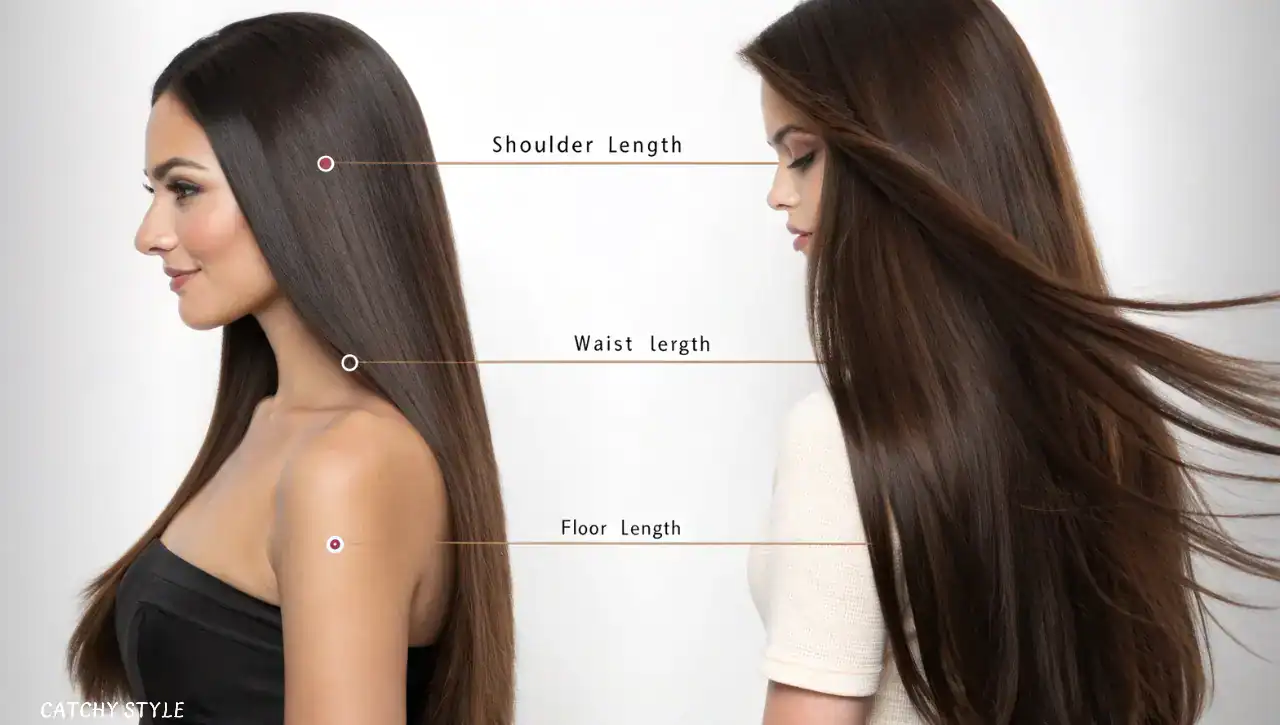
Here is a standard hair length chart commonly used across haircare industries, starting from shortest to longest:
| Hair Length Term | Approximate Length (in inches) | Description |
|---|---|---|
| Buzz Cut | 0.5 to 1 inch | Very short hair, clippers used |
| Ear Length | 2 to 4 inches | Hair reaches the top of the ear |
| Chin Length | 6 to 8 inches | Hair touches the chin |
| Shoulder Length | 12 inches | Hair falls at shoulder level |
| Armpit Length (APL) | 14 inches | Hair reaches the armpit area |
| Bra Strap Length (BSL) | 18 inches | Hair falls near the bra strap |
| Mid-Back Length | 20 inches | Hair reaches the middle of the back |
| Waist Length | 24 inches | Hair touches the waist |
| Hip Length | 28 inches | Hair reaches the hips |
| Tailbone Length | 32 inches | Hair touches the tailbone |
| Classic Length | 36 inches | Hair reaches the top of the thighs |
| Knee Length | 48 inches | Hair falls to the knees |
| Floor Length | 60+ inches | Hair reaches or touches the floor |
These are approximate values, as actual results may vary based on individual body proportions and hair textures.
Understanding Hair Growth: How to Work With Your Hair Length Chart
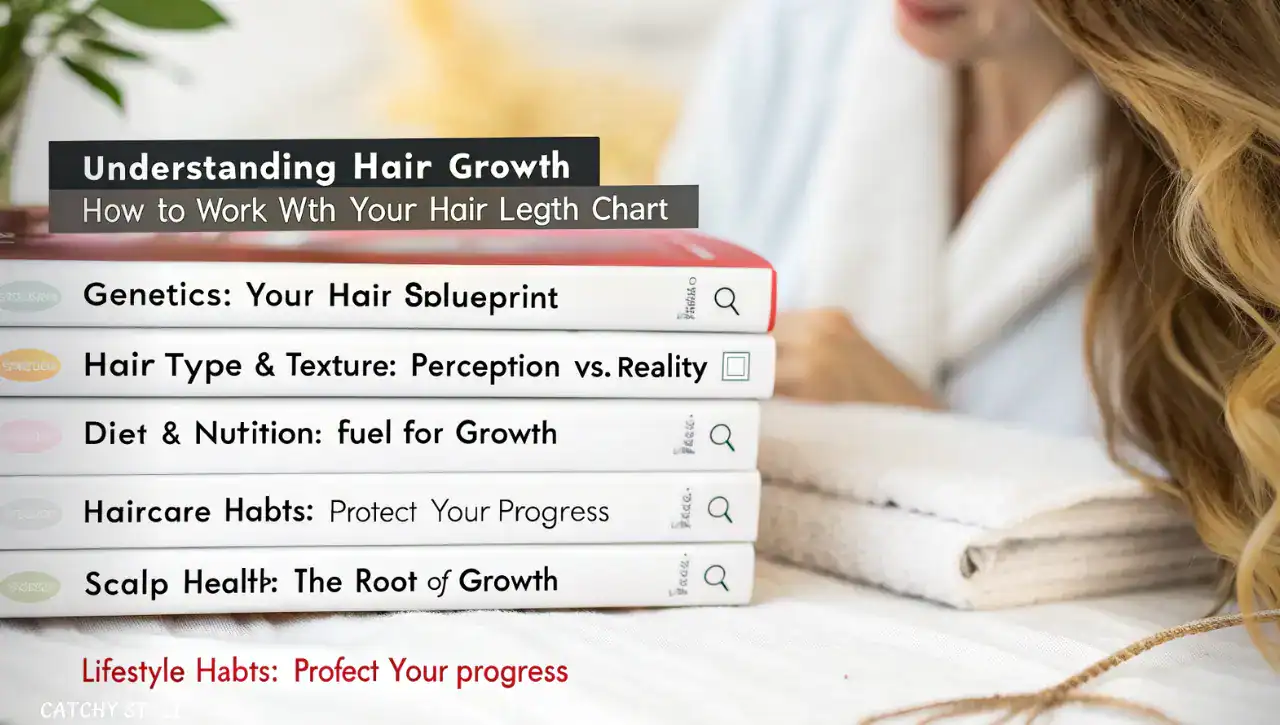
The hair length chart is a valuable tool for tracking progress, but your hair’s growth journey depends on multiple factors. Here’s how to optimize each one for better results:
Genetics: Your Hair’s Blueprint
- Growth Rate: While the average is 0.5 inches/month, your DNA determines your max potential.
- Realistic Goals: If your family tends toward thinner or slower-growing hair, adjust expectations on the chart accordingly.
Hair Type & Texture: Perception vs. Reality
- Shrinkage Factor: Curly hair (Type 3–4) can appear 30–50% shorter than its actual length—measure stretched for accuracy.
- Breakage Risks: Tight curls are prone to dryness; use leave-in conditioners and silk pillowcases to retain length.
Diet & Nutrition: Fuel for Growth
- Essential Nutrients:
- Protein (eggs, lentils) → Strengthens strands
- Iron (spinach, red meat) → Prevents shedding
- Omega-3s (walnuts, salmon) → Boosts scalp health
- Supplement Wisely: Biotin works only if you’re deficient—consult a doctor first.
Haircare Habits: Protect Your Progress
- Washing: Over-shampooing strips natural oils; aim for 2–3x/week max.
- Heat Styling: Always use a heat protectant (look for cyclomethicone or dimethicone).
- Chemical Treatments: Space out dyes/relaxers by 8–10 weeks to minimize damage.
Scalp Health: The Root of Growth
- Exfoliate: Use a salicylic acid scalp scrub monthly to unclog follicles.
- Massage: Stimulate blood flow with 2-minute daily massages (try rosemary oil diluted in jojoba).
Lifestyle: Hidden Growth Saboteurs
- Stress: High cortisol = hair loss. Try ashwagandha or meditation.
- Sleep: Poor rest disrupts growth cycles—silk bonnets reduce friction damage overnight.
Putting It All Together
Track your hair length chart progress every 3 months, but remember: health > speed. A 6-inch gain in a year with strong hair beats 8 inches of brittle strands.
Pro Tip: Take monthly photos in the same lighting/pose to visually compare growth!
How to Use the Hair Length Chart Effectively
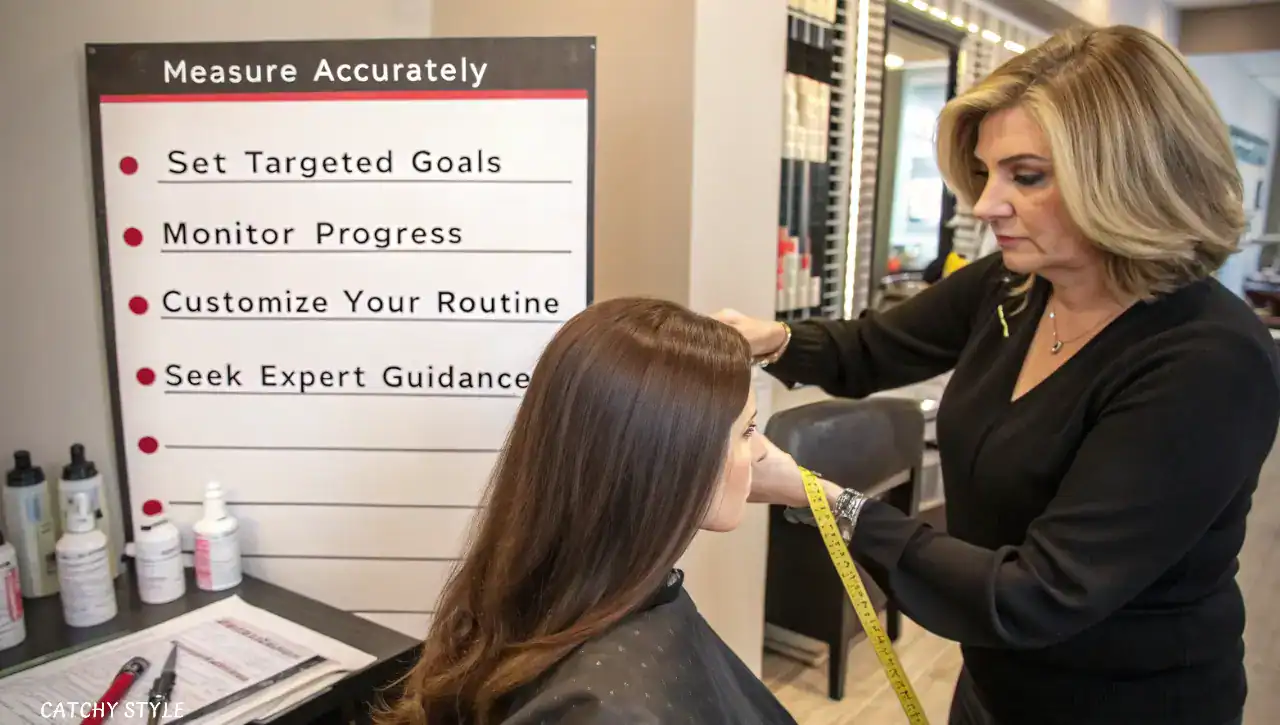
Achieving your dream hair length becomes more manageable when you use a hair length chart as your roadmap. Follow these steps to maximize its effectiveness:
Measure Accurately
- Use a flexible tape to measure from your scalp to the ends.
- Compare your results to the hair length chart to identify your current category (e.g., short, medium, long).
Set Targeted Goals
- Choose your desired length category and calculate the timeline based on average growth (0.5 inches/month).
Monitor Progress
- Re-measure every 3–6 months and log updates on the chart.
- Celebrate small wins (e.g., reaching “shoulder-length”) to stay motivated.
Customize Your Routine
- Short hair? Focus on texture and volume.
- Long hair? Prioritize hydration and split-end prevention.
Seek Expert Guidance
- Consult a stylist or trichologist to align your care routine with the hair length chart for personalized advice.
Pro Tip: Pair the chart with monthly photos for visual progress tracking!
Style Guide: Unleashing Your Hair’s Potential at Every Length
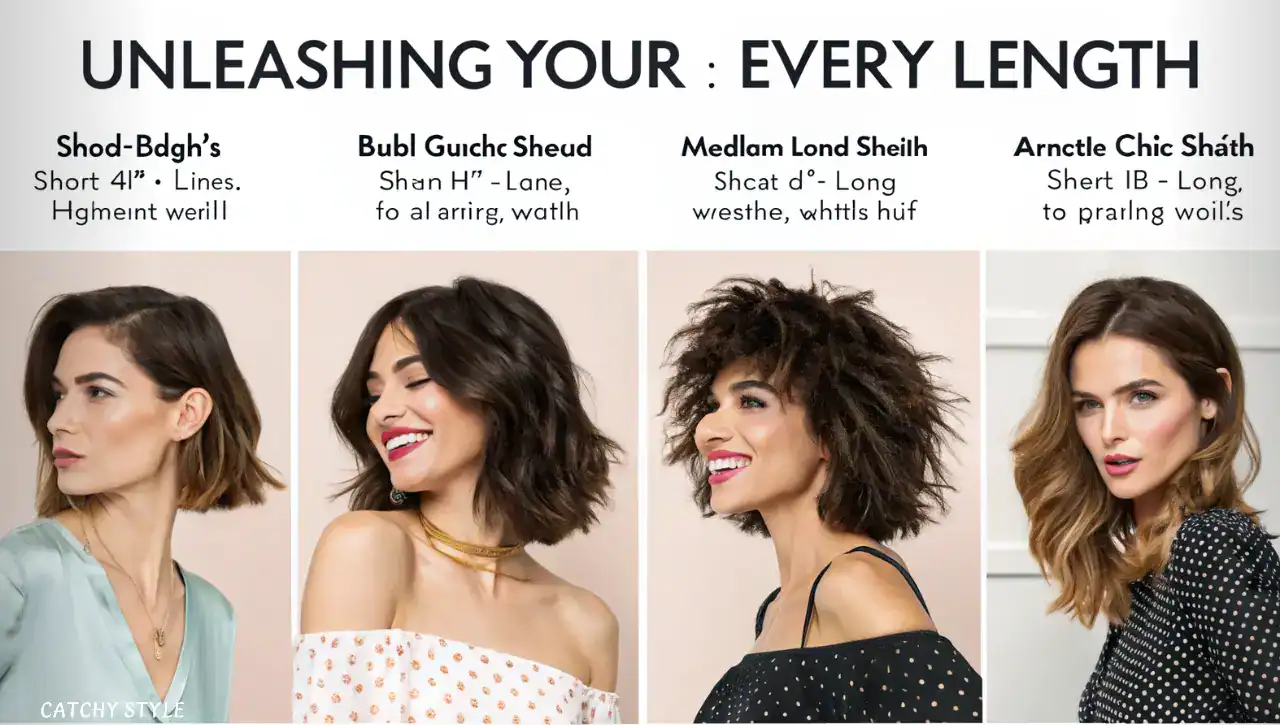
The hair length chart isn’t just a growth tracker—it’s your passport to endless styling possibilities. Here’s how to maximize each phase:
Short Hair (0–6 inches): Bold & Edgy
- Go Graphic: Asymmetrical bobs or undercut designs make a statement.
- Texture Play: Matte pomade for sharp lines, sea salt spray for piece-y grit.
- Pro Move: Temporary pastel dyes (like peach or lavender) for low-commitment flair.
Medium Hair (Shoulder–Armpit Length): Versatile Chic
- Face-Framing: Blunt bangs or face-framing layers soften features.
- Effortless Updos: Twist two small front sections back for an “indie sleaze” vibe.
- Hot Trend: ’90s blowout with a round brush for bombshell volume.
Long Hair (Armpit–Waist): Romantic & Dramatic
- Protective Styles: Crown braids or milkmaid twists prevent damage while looking ethereal.
- Heat-Free Waves: Rope-twist damp hair overnight for mermaid texture.
- Red Carpet Hack: Slicked-back low bun with face-framing tendrils = instant elegance.
Very Long Hair (Waist+): Showstopper Territory
- Length Spotlight: High ponytail with a ribbon wrap for vintage charm.
- Bohemian Vibes: Dutch braid crown + loose waves for festival-ready hair.
- Night Out: Hollywood waves with a deep side part—pin one side behind the ear.
Style Evolution: As you climb the hair length chart, revisit old lengths with new techniques—a lob (long bob) at armpit length gains drama when curled vs. straightened.
Navigating Hair Growth Challenges Using the Hair Length Chart
While tracking progress with a hair length chart is empowering, common obstacles can slow your journey. Here’s how to address them effectively:
Split Ends: The Progress Killer
- Solution: Schedule trims every 8–12 weeks and use keratin-rich deep conditioners.
- Pro Tip: Detangle with a wide-tooth comb before washing to minimize stress on ends.
Breakage: Weak Points in Your Plan
- Solution: Reduce heat tools to 1–2x weekly and swap chemical dyes for semi-permanent options.
- Game Changer: Monthly protein treatments (like rice water rinses) reinforce strands.
Slow Growth: When the Chart Stalls
- Solution: Audit your diet (prioritize iron, zinc, and omega-3s) and massage your scalp 2–3x weekly.
- Note: Supplements (e.g., biotin) work best after a doctor’s approval.
Tangles: Long Hair’s Frenemy
- Solution: Spritz detangling spray from mid-lengths to ends, and sleep in a silk-lined bonnet.
- Bonus: Braid hair before workouts to prevent knotting.
Remember: The hair length chart isn’t just a measuring tool—it’s a diagnostic guide. By addressing these hurdles head-on, you’ll see steadier progress toward your goal length.
The Hair Length Chart: A Stylist’s Secret Weapon
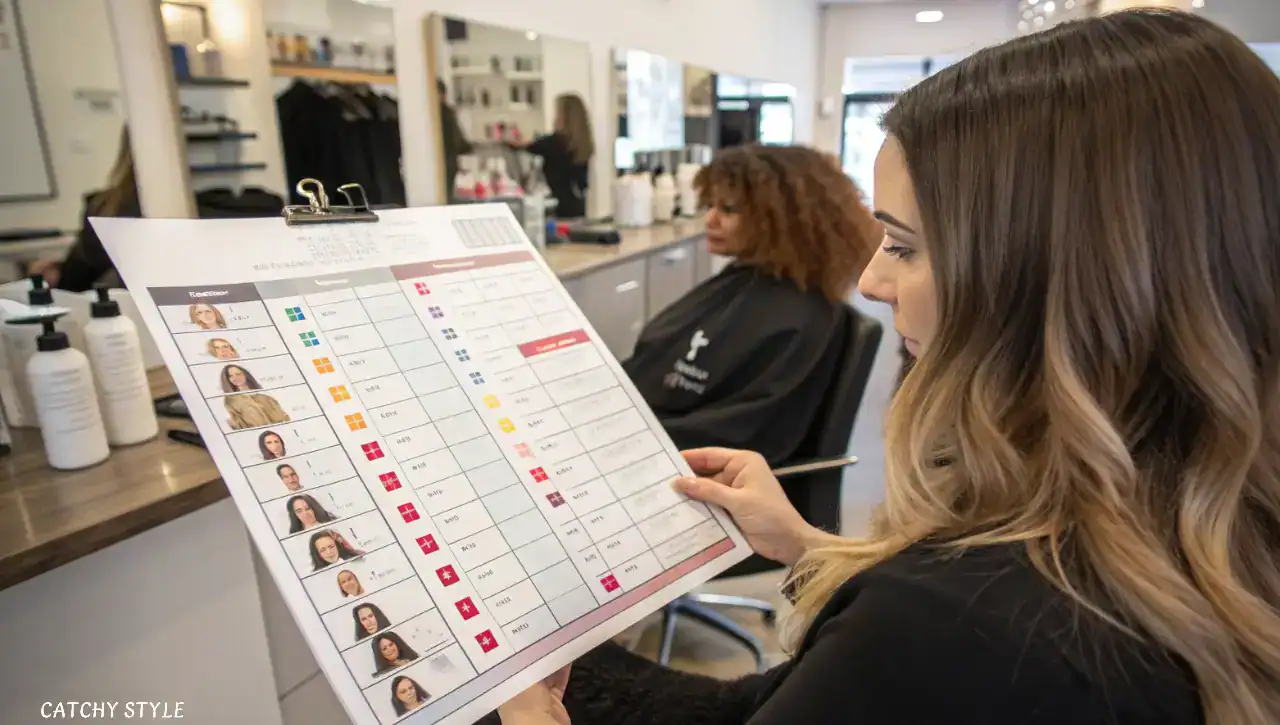
In professional salons, the hair length chart serves as a universal language for precision and client satisfaction. Here’s how stylists leverage this essential tool:
Goal Visualization & Consultation
- Clients can pinpoint their desired length (e.g., “collarbone-length” or “mid-back”) using the chart, eliminating guesswork.
- Stylists compare the client’s current hair state to their target length, creating a tailored roadmap.
Service Planning & Pricing
- Cuts/Color: Longer lengths (e.g., “waist-length”) often require more time, product, and expertise, impacting pricing.
- Extensions/Transitions: The chart helps calculate how much hair is needed for seamless blending or gradual style changes.
Client Education & Realistic Expectations
- Growth Plans: Stylists use the chart to project timelines (e.g., “6 months to reach shoulder-length from a pixie”).
- Maintenance: Demonstrates why trims are needed to preserve progress between length categories.
Pro Tip: Bring a screenshot of your goal length from the chart to consultations—it streamlines communication!
Hair Length Through the Ages
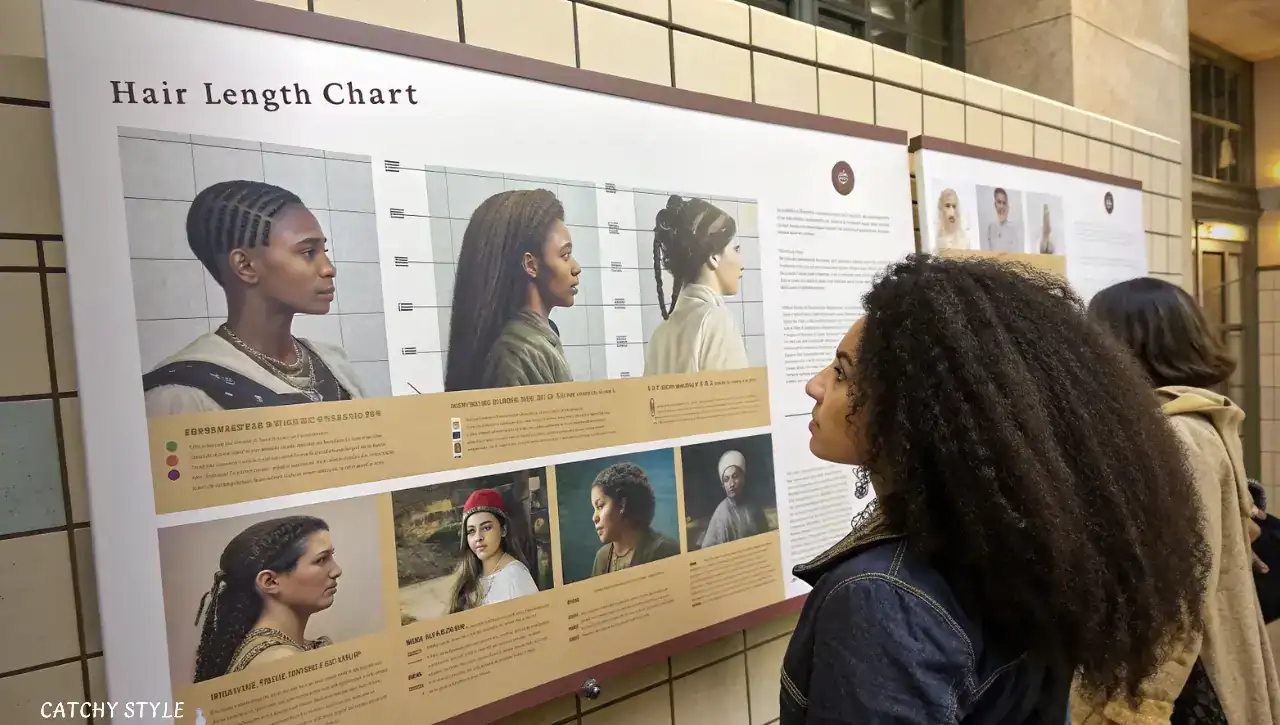
The hair length chart does more than measure inches—it reveals how hair has served as a powerful cultural cipher across civilizations. Here’s how length carries meaning beyond aesthetics:
Spiritual & Symbolic Legacy
- Native Traditions: Many Indigenous cultures view long hair as sacred—the Navajo believe it stores wisdom, while Lakota warriors grew theirs as a testament to bravery.
- Eastern Philosophies: In Hinduism, uncut hair (like Sikh kesh) represents respect for natural divinity.
Ancient Status Markers
- Egypt’s Elite: Pharaohs like Cleopatra wore intricate braids with gold beads, where length signaled proximity to the gods.
- Imperial China: During the Ming Dynasty, waist-length hair was mandatory for women as a Confucian virtue.
Modern Identity & Rebellion
- 1920s Flappers: Bobbed hair defied gender norms, while 1960s hippies used untamed length to reject conformity.
- Today’s Chart: The hair length chart now frames everything from corporate pixie cuts to waist-length “mermaid hair” as personal statements.
Why It Matters: Recognizing these layers transforms the chart from a tool into a storytelling device—one that connects your styling choices to a rich human tapestry.
Conclusion hair length chart
The hair length chart is not only a tool for measuring, but also a guide for developing the potential of your strands. Divided into short, medium, long and very long categories, it helps you to track your progress and set achievable goals.
Whether you’re getting a pixie cut or aiming for longer locks, the chart will provide you with inspiration for your hair journey. With the right care and patience, you can achieve the length and style of your dreams.





